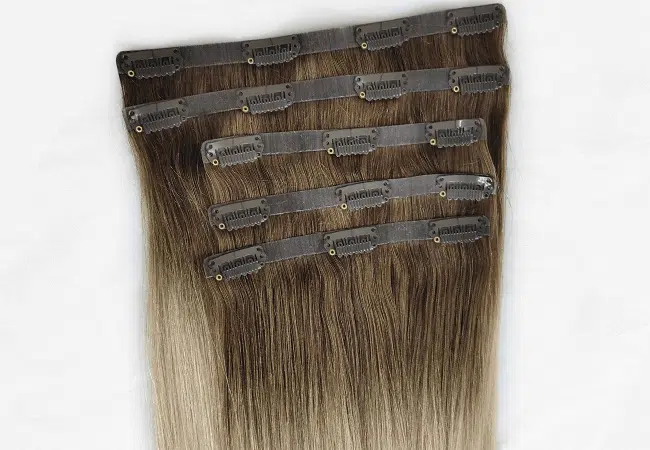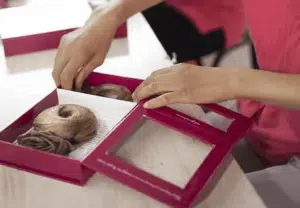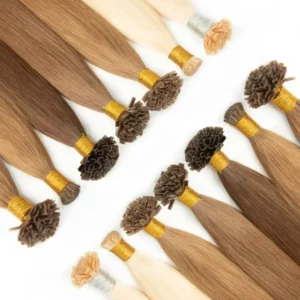Do you wonder if sleeping with clip in extensions is safe? Many people ask this. I’ll give you a clear, simple answer and an easy plan you can follow tonight.
Can You Sleep With Clip-In Hair Extensions? You shouldn’t for a full night. Clip-ins are designed for day wear. Remove them before bed to protect your scalp, your clips, and the hair. If you must nap, use safe steps and protect the roots. I’ll also answer: Can you wear your clip-in hair extensions every day? How long do clip-in extensions stay in your hair? And Can I wear clip-in hair extensions to bed?

I will explain what happens when you sleep in clip in hair extensions, what to do if you must nap, how to prepare for rare overnight cases, and which long-wear methods work better. You will see simple rules and clear checklists. I’ll also cover daily wear limits and typical wear-time in hours.
Is sleeping with clip in extensions safe?
You want a fast answer first. You also want reasons you can trust.Sleeping in clip in hair extensions is not recommended. The metal clips press on the scalp. Friction creates tangles. Roots feel stress. The wefts and the clips both wear out faster. If someone asks, “Can I wear clip-in hair extensions to bed?” the safe answer is no.
Clip-ins are a temporary system. The base is a weft with small pressure-sensitive clips. These clips anchor to sections near the scalp. During the day you sit, walk, and turn your head gently. At night you roll for hours. Your head presses into the pillow. That pressure shifts. This pressure drives the clip teeth into the same small spots on the scalp. Over many hours, that pressure can cause soreness, redness, or traction on fine roots. Friction also grows. Cotton pillowcases rub the cuticles. The cuticles lift. That creates matte tangles by morning. Brushing those tangles out pulls on the clips again. The risk goes up for very fine hair, sensitive scalps, and people who sleep hot or move a lot. There is also hardware wear. Clips bend over time. The stitches that hold clips to the weft also loosen under stress. Because of this design, the safest standard is simple: remove clip-ins before bed. If you ask, “Can You Sleep With Clip-In Hair Extensions?” the honest answer is no for a full night. It is better to remove, store flat, and start fresh in the morning. This single habit keeps the style fresh and protects your scalp.

What happens if you sleep with clip ins anyway?
You may plan to crash after a long day. You need to know the likely results.
If you sleep with clip in extensions you risk scalp tenderness, broken clips, messy tangles, and shorter product life. Morning styling takes longer and may pull more hair. “Sleeping with clip in hair extensions” is a shortcut that costs you time later.
Let’s break the risks into four parts. First, the scalp. Clip teeth focus force on small anchor points. Hours of force can make the scalp sore. People then shift the clip higher the next day to avoid pain. This creates new stress points and a cycle of soreness. Second, the hair. Friction while sleeping causes knots where clip-in wefts meet natural hair. Those knots are tight and dry. They take time to detangle. Rushed morning brushing can lift more shed hairs from the root area than normal. Third, the hardware. Clips bend with side loads. If you sleep on one side, those clips warp faster. A warped clip does not close flush. That clip then slips during the day. Fourth, hygiene. Sweat and heat build under the clip areas at night. Salt and oils stay around the anchors. This makes the hair feel greasy near the roots by morning, yet the lengths feel dry. Users then wash more often, add more heat, and repeat the cycle. You will also see shorter life for the set. Fabric at the weft edge fuzzes from friction. Stitching loosens. For these reasons, sleeping in clip in hair extensions is a poor habit for long-term use. It also answers, “can you sleep in hair extensions?”—not with clip-ins as a routine.
Can you take a nap with clip in hair extensions?
You need a plan for short rest or travel naps. You want low risk and quick setup.Short naps with clip-ins can be safer if you follow protection steps. Reduce pressure, reduce friction, and limit time. Treat naps as an exception, not a rule.
Here is a simple nap protocol. Limit the nap to 20–40 minutes. Remove side pieces that sit near temples since those feel pressure first. Keep only a small center piece if you must keep some volume for a quick meeting later. Braid the lengths into one loose, low braid to stop rolling tangles. Use a silk scarf or silk pillowcase to cut friction. Lie on your back if you can. Place a soft towel ring around the occipital area to spread pressure; this is an easy DIY travel pillow hack. Keep the room cool to reduce sweat at the scalp. When you wake, release the braid carefully. Support the base of each clip with your hand while you brush ends to roots in short passes. If anything feels tender, remove the pieces and store them. A nap is not a full night. The total force on clips is smaller. With this plan you can get rest with less risk. Still, the best habit is to remove clip-ins when you plan any sleep. If you think “can you sleep with clip ins just this once,” keep it short and follow protection steps.

How to sleep with clip in extensions if I have no choice?
Sometimes you cannot remove them. Maybe you are traveling. Maybe you lost the storage box. You need a fallback method.
If you must sleep in clip in hair extensions, reduce pressure, reduce friction, and lock the hair. Use a silk setup and a loose braid. Check anchors in the morning.
Use this emergency method only when you cannot remove the set. First, relocate clips off very fine areas. Avoid baby hairs near the hairline. Place clips into stronger sections with good density. Second, secure the lengths. Make a loose, low braid. Use a soft scrunchie. Do not use a tight elastic. Third, reduce friction. Wrap a silk scarf over the braid and under the head. Or use a silk pillowcase. Fourth, spread pressure. Use a travel pillow or a rolled towel around the neck so your head rests in the gap. This takes weight off the clips. Fifth, lower heat and humidity. A cool room helps keep sweat off the anchors. Sixth, limit time. Set an alarm to keep sleep short if possible. Seventh, morning reset. Support each clip with your hand. Open each clip. Remove the set. Brush and let the scalp settle for a few minutes. Clean the clips with an alcohol wipe if there is oil. Store the wefts flat in a breathable bag. This process lowers harm, but it does not remove risk. If someone asks, “can i sleep with clip in hair extensions?” this is the least-bad path, not a green light.
What should I do the morning after sleeping in clip-ins?
You need a repair routine. You want to save time and protect the roots.Do a gentle recovery. Detangle ends first. Clean the clips. Refresh the scalp. Rest the anchor areas before reapplying.
Start with removal. Support each base and open clips carefully. Never yank. Lay wefts on a towel. Detangle your own hair from ends to roots in short passes. Use a loop brush or a cushioned detangler. If knots sit near former anchor spots, add a small mist of water and a few drops of leave-in on lengths only. Work slowly. Next, refresh the scalp. If it feels sweaty or oily, use a root-only cleanse or a light shampoo at the scalp in the shower. Keep conditioner on the lengths, not at the roots. Blow-dry the roots fully if you washed. Clean the clips themselves with a soft cloth. If you see bent clips, set those pieces aside for repair. Let the scalp rest for at least 30–60 minutes before reapplying any pieces. This rest window lets tenderness fade and lowers the chance of placing clips on the same stressed points. When you clip them back in, use fresh anchor sections, avoid exact repeat spots, and keep tension low. This simple routine protects hair health and extends the life of sleeping in clip in hair extensions mistakes.
Are there better overnight options than clip-ins?
You want easy mornings without sore spots. You want a system that is made for overnight wear.Yes. Clip-ins are daytime tools. For overnight, look at tape-in, sew-in, or genius/hand-tied weft installs by a pro. These methods are designed to sleep in.
Let’s compare. Clip-ins attach with clips. They are meant for on/off styling. They shine for events, travel days, and photos. They are not engineered for sleep. Tape-ins bond with thin adhesive tabs that sit flat. A trained stylist installs and later moves them up. You can sleep with tape-ins because the base is soft and even. Sew-in wefts anchor to a braided or beaded track. They distribute weight across many stitches. With good tension control, they are comfortable at night. Genius or hand-tied wefts provide very thin seams. They are not DIY. A pro maps, installs, and maintains them. They are popular for daily wear and sleep. Halo pieces and pony wraps are also daytime tools. They should not be worn to bed. So if a client asks, “can you sleep in hair extensions?” the correct follow-up is, “which method?” Clip-ins get a “no.” Professionally installed systems made for long wear get a “yes, with care.” If you prefer clip-ons for day freedom, keep a set for day and plan a pro method when you want length every morning without extra steps.

Can you wear your clip-in hair extensions every day?
You want daily confidence without damage. You need simple rules.Yes, you can wear your clip-in hair extensions every day if you follow careful placement, gentle brushing, and nightly removal. Daily wear works when tension and friction stay low.
Daily wear depends on rotation and restraint. Place clips on sturdy sections and rotate positions slightly each day so you do not stress the same roots. Support clips with your hand when brushing. Keep styles that pull—like high, tight ponytails—off the plan. Limit heat passes and always use heat protectant on the lengths. Most users wear clip-ins for 6–12 hours, then remove and store them flat. This answers “How long do clip-in extensions stay in your hair?”—for a day’s styling window, not for overnight. If you need hair from morning to late night, consider removing, brushing, and re-clipping in fresh anchor spots mid-day to reset tension. Always close clips when you store the wefts. Clean clip teeth with a soft cloth weekly to remove oil build-up. These small habits keep daily wear safe and comfortable.

How long do clip-in extensions stay in your hair?
You want clear numbers to plan your day.Clip-ins are designed for one day’s wear—usually 6–12 hours—then removal. They are not made for continuous 24-hour wear or sleep.
Think of clip-ins like earrings you remove at night. You clip them in for the day, you enjoy the look, and you take them off before bed. The 6–12 hour guideline fits most schedules. The upper limit depends on your activity, heat, and scalp sensitivity. If your scalp runs oily or you work out, consider a shorter window and a quick refresh. Long, high-friction days (concerts, travel, sports) shorten the comfortable wear time. If you often hit the 12-hour mark, plan alternate anchor spots for late-day re-clipping and keep a mini brush in your bag. For events that stretch into the night, a professional overnight-friendly method (tape-in or sew-in) may serve you better. This simple rule protects both your scalp and the hardware. It also keeps the fiber looking new longer, since less night friction means fewer rescue heat passes the next morning.
Travel and emergencies: can I sleep with hair extension clip ons in during flights or road trips?
Trips can be messy. You may have no privacy to remove pieces. You need a travel plan.
Use a “travel-safe” setup: fewer pieces, loose braid, silk scarf, and a neck pillow gap. Remove and store as soon as you can.
Here is a practical plan for flights and long rides. Wear fewer wefts. Keep only the center back piece for volume and remove side pieces. Make one loose braid. Wrap a small silk scarf around the braid and secure lightly. Use a U-shaped neck pillow so the back of your head floats in the gap. This takes load off the clips. Keep the cabin cool if you can. If you wake sweaty, pat the scalp dry with tissues. As soon as you have a restroom break, open clips and store the pieces in a small, clean pouch. Carry a folding brush and a spare scrunchie. If someone asks, “can i sleep with hair extension clip ons in on a plane?” the answer is still no for full sleep. But this plan reduces harm if you must nod off. It keeps pressure and friction low and makes the morning faster. When you arrive, refresh the scalp, let the roots breathe, and reapply only after you feel comfortable.

My opinion
U recommend this rule: remove clip-ins before bed. Use them as a daytime styling tool. If someone must nap, use silk, a loose braid, and fewer pieces. For true overnight wear, switch to a professional method like tape-in, sew-in, genius, or hand-tied. This protects roots, saves time, and extends product life. For daily users, yes—you can wear your clip-in hair extensions every day with mindful placement and nightly removal. Keep each wear window at 6–12 hours for comfort and quality.
FAQ
Can You Sleep With Clip-In Hair Extensions?
No for a full night. Clip-ins are not designed for overnight pressure and friction. Remove them before bed whenever possible.
Can I wear clip-in hair extensions to bed?
It isn’t advised. If you have no choice, follow the emergency method: fewer pieces, loose braid, silk pillowcase, and a neck pillow gap. Remove at first chance.
Can you wear your clip-in hair extensions every day?
Yes, if you rotate anchor spots, brush gently, and remove before sleep. Daily wear works when tension and friction stay low.
How long do clip-in extensions stay in your hair?
Plan for 6–12 hours per day, then remove and store flat. Clip-ins are not made for 24-hour wear.
How to sleep in clip in extensions safely for a nap?
Keep naps short. Use silk, a loose braid, and remove side pieces. Support roots when brushing after.
What’s better if I want length every morning without clipping?
Choose a professional overnight-friendly method such as tape-ins or sew-in wefts. These are made for sleep when installed properly.
How to store clip-ins overnight?
Brush, close clips, align wefts, and store flat in a breathable pouch. Keep them dry and out of heat or steam.
Conclusion
Sleep and clip-ins don’t mix. Remove them at night. If you must nap, protect roots and reduce friction. Wear clip-ins daily within a 6–12 hour window, and choose a pro method for true overnight length and easy mornings.





